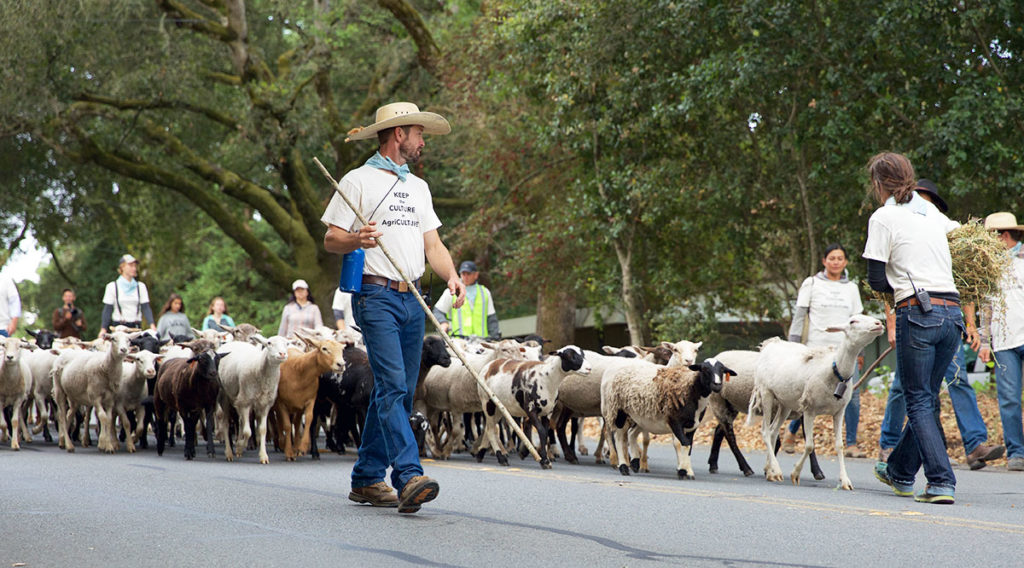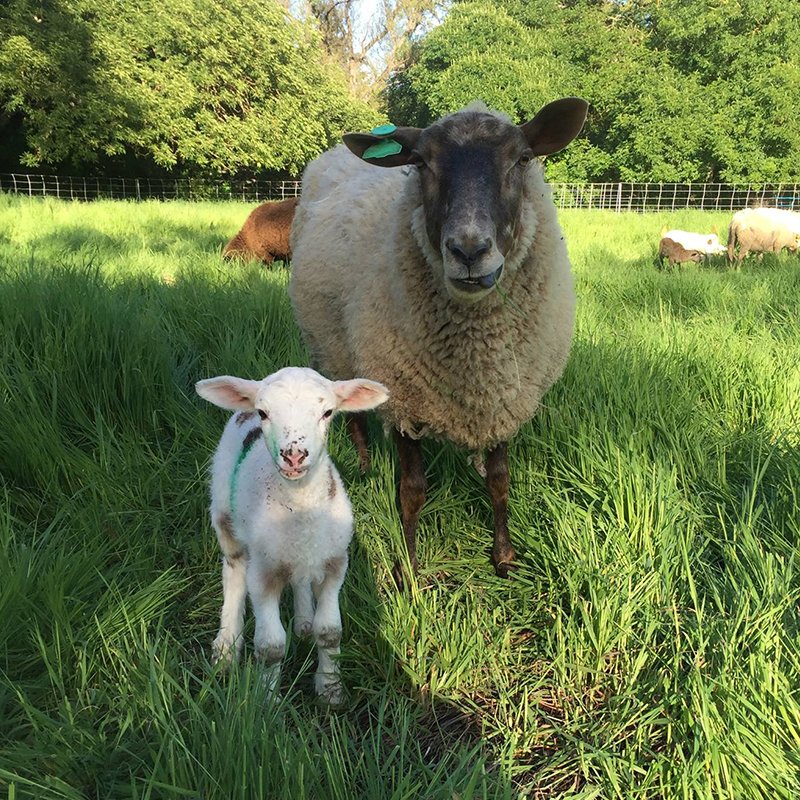“Come Sheep!” Aaron Gilliam of SweetGrass Grazing calls out to alert his flock of nearly 200 sheep to follow his lead around the south hillside of the IONS Discovery Lab. Four years ago, IONS invited SweetGrass to graze sheep at EarthRise with the intention of encouraging biodiversity in our grasslands and managing the fuel load for fire safety. By bringing the sheep to graze year after year, we are promoting the participatory ecology that considers the life cycles of the plants and animals. The wildflowers are popping, the butterflies and songbirds are flying about, and the perennial grasses will only continue to replace the invasive species introduced by European settlers. The flourishing that is appearing due to these actions of ethical land care are evidence that the sheep are promoting a diverse and resilient habitat, increasing water retention, building healthy soil, and connecting community with nature.
The sheep are a way for me to have a direct connection with the land, where I feel like I am a part, I’m deriving my sustenance from it, I’m giving back, I’m not just observing. I feel that is something we can all strive to do – find our place in it.Aaron Gilliam, Owner/Operator, SweetGrass Grazing
On May 7th the sheep returned for another year of regenerative grazing, guided by dedicated shepherds who responsibly and holistically manage the sheep to replicate the migratory species that once roamed these landscapes. A story of place is unfolding here at EarthRise, as we honor the sacredness of the land, guided by the past, held in this present moment, inspired by the future of possibility. Our community shepherds are living the ecological traditions, applying the technologies and collaborations of today, committing to regenerating the land for the future.
 Carbon, nitrogen, phosphorus – the elements in soil, born in stellar furnaces, have a history as ancient and magnificent as the divine universe. Grasses arose 80 million years ago, evidenced by fossils of herbivorous dinosaurs. During the Pleistocene period, California’s climate, geology, and sea level changes formed the coastal prairies and the Mediterranean environment, supporting one of the greatest wildlife assemblages on Earth. The diversity and abundance of prehistoric grazers, browsers, predators, and scavengers promoted the annual and perennial forb diversification, acres upon acres of wildflowers, and miles of migratory monarch butterflies.
Carbon, nitrogen, phosphorus – the elements in soil, born in stellar furnaces, have a history as ancient and magnificent as the divine universe. Grasses arose 80 million years ago, evidenced by fossils of herbivorous dinosaurs. During the Pleistocene period, California’s climate, geology, and sea level changes formed the coastal prairies and the Mediterranean environment, supporting one of the greatest wildlife assemblages on Earth. The diversity and abundance of prehistoric grazers, browsers, predators, and scavengers promoted the annual and perennial forb diversification, acres upon acres of wildflowers, and miles of migratory monarch butterflies.
The coastal Miwok Tribe of the Lekatuit Nation, who settled along San Antonio Creek on land that is now part of EarthRise, had a deep relationship with the natural world. The Miwok were stewards influenced by wisdom passed down through generations, teachings from the wild life, the rituals of the cycles, seasons, and elements, the shifting map of stars and the lessons and stories of the moon and sun. Gardening the rolling seas of perennial grasses, roaming among the enormous herds of deer and elk, gathering acorns from the groves of oaks, pruning and wild-tending the sedge and brush, harvesting herbs, roots, and seeds. It was a reciprocal relationship of nourishment.
When the Spanish Missionaries arrived in the mid-1700s with their ranch livestock (cattle, horses, and yes, sheep) these traditional practices were disrupted. As European settlers moved west, foreign and aggressive seed species were introduced, choking out native grasses. The overgrazing of livestock, plowing for crops, and the development of homesteads resulted in degraded soils, major disruption of native animal and plant habitats, and eradication of the sacred relationship the indigenous peoples had with the land.
Beneath our feet, there is a miraculous mycelium network of symbiotic relationships – billions upon billions of vibrations and exquisite energies magnifying into the expanses of the universe, an intricate and beautiful cosmic display of absolute connection. When pondering the possibilities, the opportunities, the relations of place, the stories of our past, and our responsibility of daily practices in the present, we can commit to addressing the needs of the planet, honoring the soil, the stars, and everything in between, while activating the global heart. Guests at EarthRise are able to immerse themselves into the wonderment of nature, themselves, and community.
 The sheep will be grazing EarthRise for the next four to five weeks. If you won’t be on campus to experience the joys of the sheep, join the shepherds on Saturday, May 11th in Petaluma, California, for a community celebration of grassland culture, resiliency, and regenerative agriculture. The sheep will be guided down the road, through neighborhoods, into the town’s center to the old Heritage Barn along the Petaluma River for The Transhumance Festival.
The sheep will be grazing EarthRise for the next four to five weeks. If you won’t be on campus to experience the joys of the sheep, join the shepherds on Saturday, May 11th in Petaluma, California, for a community celebration of grassland culture, resiliency, and regenerative agriculture. The sheep will be guided down the road, through neighborhoods, into the town’s center to the old Heritage Barn along the Petaluma River for The Transhumance Festival.
